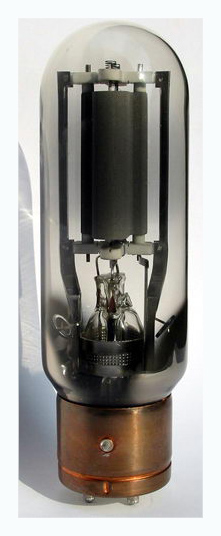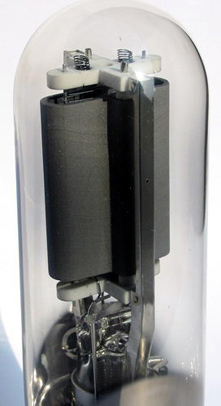|
You are reading the older HTML site
Positive Feedback ISSUE
15
Tube rolling with the 845B from Shuguang
Tube rolling is one of the joys of having vacuum tube equipment. If you don't like the way your equipment sounds, just swap one brand of tubes for another. The sound will almost always change, but whether the change is an improvement or just a change is not always obvious. Usually, if you want to improve the sound of your equipment, you need to swap your existing tubes for new, old stock (NOS) tubes. Depending on the type of tube and the brand, NOS tubes can cost a few dollars to hundreds of dollars. In the case of power triodes, NOS tubes, particularly the better brands, can be very pricey. For example, many people feel that a NOS RCA 845 is the creme de la creme. If you can find an RCA 845 in near-new condition, the asking price will usually be over $300. At those kinds of prices, tube rolling can be expensive. Because of the cost of NOS 845s or the almost-as-expensive Kron 845 ($550 per matched pair), most people use the 845 in current production at the Shuguang factory in China. The standard 845 made by Shuguang is not a bad tube. It sounds very nice, and at $39.95 per tube it is quite a bargain, but we wouldn't be audiophiles if we weren't always looking for something better. The Shuguang factory has heard our cries, and has released a new version of the 845, the 845B, that is supposedly based on the Amperex 845. In the standard Shuguang 845, the plate structure is braced against the top of glass envelop by a mica bridge. This anchors everything so that the plate structure does not rattle around, but the result is that vibrations hitting the glass envelope will be transmitted inside the tube to the plate structure via the mica bridge. The Shuguang 845B eliminates the mica bridge by having strong posts that are anchored in the tube base, and that run up the tube on both sides. This may be only part of the story. 845s are not one of the more microphonic tube types. If you tap them with a pencil while playing music, the taps don't sound as loud as they do with other tube types. I use Herbie's Audio Lab tube dampers (reviewed in PFO Issue 7) on all of my tubes, but putting dampers on either standard Shuguang 845s or 845Bs does not have much effect. From this, I theorize that the sonic differences between the 845 and 845Bs are not due to the removal of the mica bridge, but to other changes in construction. When the 845B was originally released in June of this year, Ed Sawyer posted a nice technical review of the new tube on Audio Asylum (see www.audioasylum.com/audio/tubes/messages/144597.html). This review, plus favorable comments by other Asylum inmates, prompted me to order a pair of 845Bs for my deHavilland 845-G monoblock amps (reviewed in PFO Issue 12). Currently, the only source of the 845Bs is www.supertnt.com. The tube is listed on the Valve Arts web page (www.jacmusic.com/valveart/intro.htm), but I could not find a Valve Arts dealer that had them in stock. I ordered the tubes from www.supertnt.com on a Friday, and they arrived via DHL courier the following Wednesday. The 845Bs are supposed to require eight hours of burn-in before they sound their best. Right out of the box, though, I knew they were significantly better than the standard Shuguang 845s. They did have a slightly nasal sound, but the sound went away as the tubes burned in, and after six hours I did not hear any further change. How do the 845Bs compare to the standard Shuguang 845s? Making direct comparisons, I heard the following:
Next up was "Summoning of the Muse," band 3 of side two on the Dead Can Dance album Within the Realm of a Dying Sun (4AD CAD 705). With the 845Bs, the sound was slightly darker, the hall was slightly larger, and the initial strokes of the hammer hitting the chimes were clearer. Lisa Gerrard's voice had slightly more detail, and all of the sounds came out of a blacker background. "Dueling Banjoes," the first band of the soundtrack to Deliverance (Electra BS 2683), consists of one guitar and one banjo playing back and forth. With the 845Bs, I heard more of the subtle inner details that you hear in live music. The sound of fingers sliding on guitar strings and of the pick rasping on the banjo strings was more audible, and because of this, the instruments sounded much more lifelike. Moving on to CDs, the first was Bela Fleck and the Flecktones' Flight of the Cosmic Hippo (Warner Bros 26562-2). On track 3, "Turtle Rock," I heard a repeat of what I had heard on vinyl. The music emerged from a blacker background and sounded smoother. There was more low-level detail, more bass slam, and the subtle changes in texture of the harmonica, which were inaudible with the standard 845s, were clearly audible with the 845Bs. The last comparison was with the final movement from Barber's Violin Concerto with Hilary Hahn (Sony SK 89029). With the 845Bs, Ms. Hahn moved back a few feet. The sound was slightly darker, and again, subtle details such as the sound of the bow on the strings were more apparent than they were with the standard 845s. To summarize, the advantages of the Shuguang 845B tubes over the standard Shuguang 845 included less noise, better handling of low frequencies, a smoother, more natural sound, and greater detail. The main disadvantage of the 845Bs versus the standard Shuguang 845s is increased costó$75 against $39.95. Other considerations include the 845Bs' slightly darker sound and the fact that they moved the soundstage back a couple of feet. The sonic differences between the new Shuguang 845Bs and the standard 845s are not subtle. It is like going from a $1500 preamp to a $4000 preamp. You can enjoy the music through both, but once you have heard the $4000 preamp it is hard to go back to the cheaper one. Buying a matched pair of 845Bs for $150 seems a no-brainer to me. The 845Bs give tremendous bang for the buck. The only downside I can see is that Shuguang is supposed to release a metal plate 845 (845M) before the end of this year. Metal plate 845s are supposed to sound better than any of the graphite plate 845s, including the 845B. I hope the 845M becomes a reality, but in the meantime, if you have an 845 amp but don't have the bucks to buy NOS 845s, I suggest that you spend the bucks you do have on the Shuguang 845Bs. Roger S. Gordon
|


 I started with vinyl. On
"Dehlia's Gone," the
first band on Johnny Cash's Cash (American Recordings 9362-45520-1), the
music emerged from a blacker, more silent background with the 845Bs. Johnny's
voice was smoother, and he seemed to have moved a couple of feet further back.
The sound of his fingers moving on the strings of his guitar was more evident.
On "You Were on My Mind" and "Moonshine Can," the first two bands of Ian &
Sylvia's Northern Journey album (Cisco reissue of Vanguard VSD-79154),
the 845Bs sounded ever so slightly darker than the standard 845s. With the
845Bs, Ian's position in space was more clearly delineated, and Sylvia's
autoharp sounded more natural and textured. The vocals were slightly clearer and
easier to understand. "Vampire Hunters," band two on the soundtrack to the movie
Bram Stoker's Dracula (Sony 99747-274619) is an excellent test of lower
frequencies. With the 845Bs, the leading edges of bass drum strokes were
cleaner, the sound of the drum was tighter, and the bass had more authority and
slam.
I started with vinyl. On
"Dehlia's Gone," the
first band on Johnny Cash's Cash (American Recordings 9362-45520-1), the
music emerged from a blacker, more silent background with the 845Bs. Johnny's
voice was smoother, and he seemed to have moved a couple of feet further back.
The sound of his fingers moving on the strings of his guitar was more evident.
On "You Were on My Mind" and "Moonshine Can," the first two bands of Ian &
Sylvia's Northern Journey album (Cisco reissue of Vanguard VSD-79154),
the 845Bs sounded ever so slightly darker than the standard 845s. With the
845Bs, Ian's position in space was more clearly delineated, and Sylvia's
autoharp sounded more natural and textured. The vocals were slightly clearer and
easier to understand. "Vampire Hunters," band two on the soundtrack to the movie
Bram Stoker's Dracula (Sony 99747-274619) is an excellent test of lower
frequencies. With the 845Bs, the leading edges of bass drum strokes were
cleaner, the sound of the drum was tighter, and the bass had more authority and
slam.